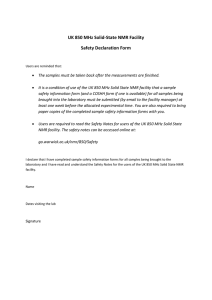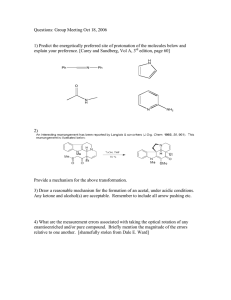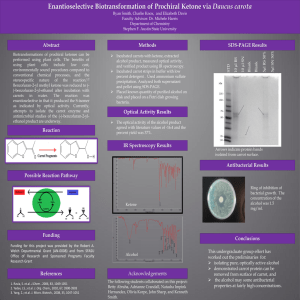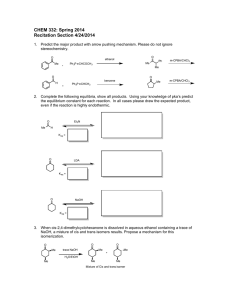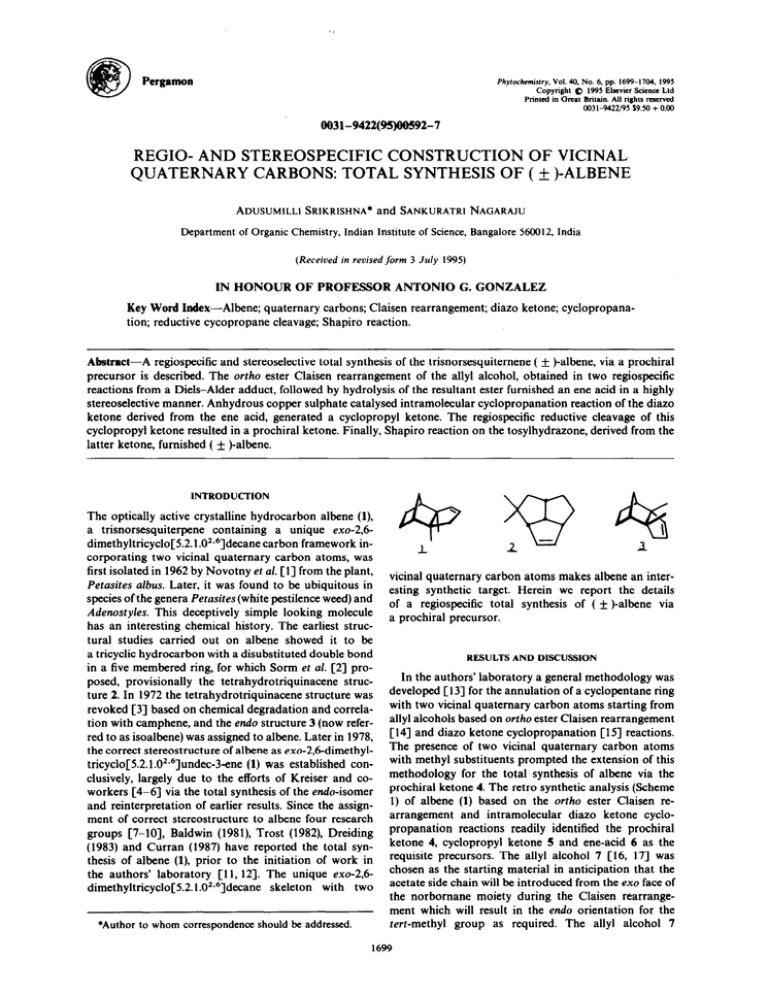
Pergnmon
Phytochemistry.
Vol. 40. No. 6, pp. 16!39-1704, 1995
Copyright
Q 1995 Elsevicr Scicna
Ltd
Printed in Great Britain. All rights reserved
0031~9422/95 19.50 + 0.00
0031-9422(%)00592-7
REGIO- AND STEREOSPECIFIC
CONSTRUCTION
OF VICINAL
QUATERNARY
CARBONS: TOTAL SYNTHESIS OF ( f )-ALBENE
ADUSUMILLI
SRIKRISHNA* and SANKURATRI NAGARAJU
Department of Organic Chemistry, Indian Institute of Science, Bangalore 560012, India
(Receivedin revisedform 3 July 1995)
IN HONOUR
OF PROFESSOR
ANTONIO
G. GONZALEZ
Key Word Index-Albene;
quaternary carbons; Claisen rearrangement;
tion; reductive cycopropane cleavage; Shapiro reaction.
diazo ketone; cyclopropana-
Ahstrrct-A
regiospecific and stereoselective total synthesis of the trisnorsesquiternene ( f )-albene, via a prochiral
precursor is described. The ortho ester Claisen rearrangement of the ally1 alcohol, obtained in two regiospecific
reactions from a Diels-Alder adduct, followed by hydrolysis of the resultant ester furnished an ene acid in a highly
stereoselective manner. Anhydrous copper sulphate catalyzed intramolecular cyclopropanation reaction of the diazo
ketone derived from the ene acid, generated a cyclopropyl ketone. The regiospecific reductive cleavage of this
cyclopropyl ketone resulted in a prochiral ketone. Finally, Shapiro reaction on the tosylhydrazone, derived from the
latter ketone, furnished ( f )-albene.
INTRODUCTION
The optically active crystalline hydrocarbon albene (l),
a trisnorsesquiterpene
containing a unique exo-2,6dimethyltricyclo[5.2.1.02~6]decane carbon framework incorporating two vicinal quaternary carbon atoms, was
first isolated in 1962 by Novotny et al. [l] from the plant,
Petasites albus. Later, it was found to be ubiquitous in
species of the genera Petasites (white pestilence weed) and
Adenostyles. This deceptively simple looking molecule
has an interesting chemical history. The earliest structural studies carried out on albene showed it to be
a tricyclic hydrocarbon with a disubstituted double bond
in a five membered ring, for which Sorm et al. [2] proposed, provisionally the tetrahydrotriquinacene
structure 2. In 1972 the tetrahydrotriquinacene
structure was
revoked [3] based on chemical degradation and correlation with camphene, and the endo structure 3 (now referred to as isoalbene) was assigned to albene. Later in 1978,
the correct stereostructure of albene as exo-2,6-dimethyltricyclo[5.2.1.02*6]undec-3-ene (1) was established conclusively, largely due to the efforts of Kreiser and coworkers [4-61 via the total synthesis of the endo-isomer
and reinterpretation of earlier results. Since the assignment of correct stereostructure to albene four research
groups [7-lo], Baldwin (1981), Trost (1982), Dreiding
(1983) and Curran (1987) have reported the total synthesis of albene (l), prior to the initiation of work in
the authors’ laboratory [ll, 123. The unique exo-2,6dimethyltricyclo[5.2.1.02@Jdecane
skeleton with two
*Author
to
whom correspondence
should be addressed.
vicinal quaternary carbon atoms makes albene an interesting synthetic target. Herein we report the details
of a regiospecific total synthesis of ( + )-albene via
a prochiral precursor.
RESULTS AND DISCUSSiON
In the authors’ laboratory a general methodology was
developed [ 131 for the annulation of a cyclopentane ring
with two vicinal quaternary carbon atoms starting from
ally1 alcohols based on ortho ester Claisen rearrangement
[ 143 and diazo ketone cyclopropanation [ 1S] reactions.
The presence of two vicinal quaternary carbon atoms
with methyl substituents prompted the extension of this
methodology for the total synthesis of albene via the
prochiral ketone 4. The retro synthetic analysis (Scheme
1) of albene (1) based on the ortho ester Claisen rearrangement and intramolecular diazo ketone cyclopropanation reactions readily identified the prochiral
ketone 4, cyclopropyl ketone 5 and ene-acid 6 as the
requisite precursors. The ally1 alcohol 7 [16, lfl was
chosen as the starting material in anticipation that the
acetate side chain will be. introduced from the exo face of
the norbomane moiety during the Claisen rearrangement which will result in the endo orientation for the
tert-methyl group as required. The ally1 alcohol 7
1699
A. SRIKRISHNAand S. NAGARAJU
1700
49p-$--Y
&L-&
1
0
Scheme 2. (a) i 140”, sealed tube, 5 hr; ii CH2N2, Et,O. (b)
i Hz-lo% Pd/C, 1 atm, 1.5 hr; ii DIBAH, PhMe, - 78”, 1hr.
6
Scheme 1. Retro synthetic analysis of albene.
was prepared
in a straightforward manner starting
from cyclopentadiene. Since the Diels-Alder reaction of
cyclopentadiene with methyl tetrolate resulted in low
yield of the adduct 8, Diels-Alder reaction was carried
out using tetrolic acid. Thus reaction of cyclopentadiene
and tetrolic acid in a sealed tube at 140” for 5 hr, followed
by esterification of the adduct 9 with an excess of ethereal
diazomethane furnished the ester 8 in 80% yield. The
regiospecific hydrogenation of the less substituted olefin
of the ester 8, using lo%-Pd/C as catalyst in ethyl acetate
at atmospheric pressure of hydrogen, furnished the
dihydro derivative, the ester 10.Since the reaction of the
ester 10 with LAH was found to generate a mixture of
ally1 and saturated alcohols, it was reduced with
diisobutylaluminium
hydride (DIBAH) in toluene at
- 78” to furnish the ally1 alcohol 7, the requisite starting
material for the Claisen rearrangement, in 92% yield
(Scheme 2).
The first quaternary carbon atom of albene was introduced using a highly stereoselective ortho ester Claisen
rearrangement [14]. Thus, thermal activation of a solution of the ally1 alcohol 7 and a catalytic amount of
propionic acid in triethyl ortho-acetate for 48 hr at 180
generated the ene-ester 11 [ 163 in 81% yield, whose
structure was delineated from its spectral data. The steritally preferred exo transition state 12 over the endo
transition state 13 explains the exclusive formation of the
exo product 11.The long reaction time required for this
rearrangement was drastically reduced by employing
a microwave oven [18]. Thus, microwave irradiation of
a solution of the allylic alcohol 7, triethyl ortho-acetate
and a catalytic amount of propionic acid in dry DMF in
a clean Erlenmeyer flask for 14 min in a commerical
microwave oven furnished the ester 11 in 87% yield.
Hydrolysis of the ester 11 using 20% aqueous sodium
hydroxide in methanol furnished the key intermediate of
the sequence, the ene-acid 6, m.p. 85-87”, 76% yield.
The second quaternary carbon atom was created employing a copper catalysed intramolecular diazo ketone
cyclopropanation
reaction [15]. Reaction of the acid
6 with oxalyl chloride in benzene at room temperature
furnished the acid’chloride 14 which on treatment with
an excess of freshly prepared ethereal diazomethane at 0
generated the diazo ketone 15. Anhydrous copper sulphate catalysed decomposition of the diazo ketone 15 in
refluxing cyclohexane, using a 100 W tungsten lamp for
5 hr, generated the cyclopropyl ketone 5 in 53% yield
(from acid 6) via the intramolecular insertion of the
resultant keto carbenoid into the exo-methylene whose
structure rests secured from its spectral data (Scheme 3).
The preferential formation of the cyclopropyl ketone
5 was a consequence of the insertion of the ketocarbenoid
from the exo face of the molecule as it cannot approach
from the other face of the double bond. This forces the
cyclopropyl methylene to occupy the endo position,
namely cis with respect to the endo tert-methyl group,
thus creating the two quaternary centres in a highly
stereoselective manner. The cyclopropyl ketone 5 was
then transformed into the prochiral ketone 4, by the
regiospecific cleavage of the C3-C4 bond of the cyclopropane ring. Thus, reduction of the cyclopropyl ketone
5 using lithium in liquid ammonia for 15 min at - 33”,
regiospecifically furnished the prochiral ketone 4 in 8 I %
yield generating the second endo tert-methyl group. Both
the ‘H and 13C NMR (seven lines) spectra clearly revealed
the presence of a plane of symmetry in the molecule.
The regiospecificity in the cyclopropane ring cleavage
can be readily explained [19] as it is well established that
in the reduction of cyclopropyl ketones with lithium in
liquid ammonia, of the two possibilities, the cyclopropane bond which is having maximum overlap with
the p-orbital of the carbonyl system will be cleaved.
Alternate to the reduction with lithium in liquid ammonia, catalytic hydrogenation (40 psi ( z 276 kPa), HZ10% Pd/C, methanol, 5 hr) of the less substituted cyclopropane bond also transformed the cyclopropyl ketone
5 into the prochiral ketone 4 in quantitative yield.
The last phase in the synthesis, i.e. conversion of the
ketone 4 into albene, requires the transformation of
a cyclopentanone to a cyclopentene. For this purpose,
a Shapiro reaction [20,21] on the corresponding tosylhydrazone was adopted. Thus, treatment of the ketone
4 with tosylhydrazide in refluxing ethanol for four hours
formed the tosylhydrazone
16, m.p. 162”, in 86%
yield. Finally, treatment of the tosylhydrazone 16 in
N,N,N’,N’-tetramethylethylenediamine
(TMEDA) and
ether with an excess of n-butyllithium furnished ( k )albene (l), m.p. 1 lo- 115”(lit. Cl] 1 lo- 115”) in 65% yield.
The ‘H and 13C NMR spectra of our synthetic albene
were found to be identical with those reported [S] in the
literature for the natural product.
Total synthesis of ( f )-albene
1701
d
I
Scheme 3. (a) i MeC(OEt),, EtCOOH; sealed tube, 180”,48 hr or DMF, microwave irradiation, 14 min. (b) i Aq.
NaOH, MeOH, 70”, 6 hr; ii CsH,, (COCl),, RT, 2 hr. iii CH2N2. Et,O, 2 hr. (c) Anhydrous CuS04, c-C6Hi2,
W-lamp, 5 hr. (d) Li-liquid NH,, 15 min or Hz-lo% Pd/C, 40 psi, 5 hr. (e) NH,NH-Ts, EtOH, reflux, 4 hr. (f)
n-BuLi, Et,O, TMEDA, o”, 6 hr.
Chirol amide
)
OR
@l.
0
Chirol omidc
*
1)
WI. 2)
In conclusion, a stereoselective and regiospecific total
synthesis of ( f )-albene (1) was achieved via the
prochiral ketone 4 using the ortho ester Claisen rearrangement and intramolecular diazo ketone cyclopropanation reaction as key steps for the construction of
the two vicinal quaternary carbons. It is evident from the
foregoing discussion that if a methodology is available
for the converison of a prochiral cycloalkanone to
a chiral cycloalkene, the ketone 4 can serve as a precursor
to chiral albene. Recent reports on the conversion of
prochiral ketones to chiral alkenes employing chiral amides [22] either for elimination [23] (equation 1) or
generation of chiral enolates [24] (equation 2), enhanced
the significance of the present synthesis, as a potential
route to chiral albene.
EXPERIMENTAL
Melting points are not corrected. The chemical shifts
(6 ppm) and coupling constants (Hz) in ‘H (60 and
90 MHz) and 13C NMR (22.5 MHz) spectra are reported
with reference to either internal tetramethylsilane (for
‘H) or central line (77.1 ppm) of CDC13 (for 13C). In the
’3C NMR spectra off-resonance multiplicities, when recorded are given in parentheses. Low- and high-resolution mass measurements were carried out using a direct
inlet mode. Relative intensities of the ions are given in
parentheses. Elemental analyses were carried out using
a Carlo Erba 1106 analyser. Acme’s silica gel (100-200
mesh) was used for column chromatography. Cyclopentadiene was freshly prepared by cracking dicyclopentadiene at 180”. Tetrolic acid and N-nitroso-N-methylurea were prepared according to the reported procedures
~251.
Methyl 3-methylbicyclo[2.2.1]hepta-2,5-diene-2-carboxylate (8)
(1) Diels-Alder reaction. A solution of tetrolic acid
(5 g, 59 mmols), freshly distilled cyclopentadiene (5 g,
75 mmols) and a catalytic amount of hydroquinone in
toluene (10 ml) was taken in a Carius tube in N1 and
heated at 140” for 5 hr. The Carius tube was cooled,
saturated solution of aqueous NaHCO, (50 ml) was added to the reaction mixture and washed with CH2C12
(3 x 30 ml) to remove the dicyclopentadiene and other
oligomers. The aqueous phase was acidified with 10%
aqueous HCl and extracted with CH2C12 (3 x 30 ml). The
CHzClz layer was washed with water and brine, and
dried (Na2S04). Evaporation of the solvent and filteration of the residue through a silica gel (5 g) column using
CH2C12 as eluant furnished the adduct 9 ( z 8 g) as
a dark low melting solid. ‘H NMR (90 MHz, CDC13):
S6.92 and 6.72 (2H, d of ABq, J5,6 = 4.5 Hz,
J1,6 = J4,5 = 3 Hz, H-5 and 6), 3.90 (lH, br s, H-4), 3.41
(lH, brs, H-l), 2.29 (3H, s, olefinic CH3), 2.31 and
199(2H, t of AB q, J7n,,b = 9 Hz, J1,, = J4,, = 2 Hz,
H-7).
(2) Esterijication. The acid 9, obtained above, was
taken in ether (25 ml) and treated with freshly prepared
[25] ethereal diazomethane (from 10 g of N-nitroso-Nmethylurea and 100 ml of 50% aqueous KOH). Careful
evaporation of the solvent and excess diazomethane followed by purification of the residue over a small silica gel
(5 g) column using hexane as eluant furnished the ester
8 (7.75 g, 80%) as an oil [17-J. IR (neat): v_ cm-’ 3070
(=C-H), 1713 (C=O), 1635 (C=C), 1437, 1341, 1320,
1296,1239, 1194, 1101,1068. ‘H NMR (60 MHz, CCL):
86.60-7.00(2H, m, olefin), 3.90(1H, brs, H-4), 3.72(3H,s,
0-CH3), 3.40 (lH, br s, H-l), 2.23 (3H, s, olefinic CH3),
2.00 (2H, m, H-7). “C NMR (22.5 MHz, CDC13):
6169.5 (s, O-X=0),
165.8 (s, C-3), 143.8 (d) and
140.1 (d) (C-5 and 6), 137.9 (s, C-2), 70.7 (t, C-7),
57.8 (d, C-4), 50.8 (q, O-CHJ), 50.5 (d, C-l), 16.9 (q,
C3-CH3).
Methyl 3-methylbicyclo[2.2.1]hept-2-en-2-carboxylate
(W.
To a solution of the ester 8 (6 g, 36.5 mmol) in EtOAc
(15 ml) was added lo%-Pd/C (60mg) and stirred under
1702
A. SRIKRISHNAand
hydrogen atmosphere (balloon) for 1.5 hr. The reaction
mixture was then filtered through a small silica gel (5 g)
column. Evaporation of the solvent furnished the hydrogenated ester 10 (6 g, 99%) as an oil. IR (neat): v,,, cm-’
1713 (C=O), 1632 (C=C), 1437, 1359, 1281, 1257, 1203,
1161, 1092, 1056. ‘H NMR (60 MHz, CCIJ: 63.63 (3H, s,
0-CH3), 3.15 (lH, brs, H-4), 2.75 (lH, brs, C-l), 2.16
(3H, s, olefinic CH,), 0.95-1.90 (6H, m, H-5, 6 and 7).
13C NMR (22.5 MHz, CDC13): 6 165.8 (s, O-C=O), 160.0
(s, C-3), 131.8 (s, C-2), 50.4 (q, 0-CHJ), 49.9 (d, C-4), 45.9
(t, C-7), 43.1 (d, C-l), 26.2 (t) and 24.4 (t) (C-5 and 6), 14.4
(q, olefinic CH&.
(3-Methylbicyclo[2.2.1]hept-2-en)-2-methanoI
(7). To
a cold ( - 78”) magnetically stirred solution of the ester
10 (5.5 g, 33 mmol) in dry toluene (25 ml) was added
a solution of DIBAL-H (1.2M in toluene, 30 ml, 36 mmol)
and the reaction was allowed to attain room temperature
over a period of 1 hr. The reaction was then quenched
with water. The solids were filtered off and the residue
was washed with ether (25 ml). The combined organic
phase was dried (Na$O,) and the solvent was evaporated. Purification of the residue on a silica gel (15 g)
column using EtOAc-hexane (1:9) as eluant furnished
the alcohol 7 (4.2 g, 92%) as an oil [17]. IR (neat):
vmsx cm -’ 3340 (OH), 1692, 1446, 1278, 993. ‘H NMR
(90 MHz, CDC13): 64.21 and 4.00 (2H, ABq, J = 12.6 Hz,
CI-I,OH), 2.90 (lH, br s) and 2.60 (lH, br s) (H-l and 4),
1.68 (3H, s, olefinic CHs), 0.90- 1.70 (6H, m, H-5,6 and 7).
“C NMR (22.5 MHz, CDCla): 6140.0 (s) and 139.1 (s)
(olefinic), 57.4 (t, CH,OH), 47.8 (d) and 43.5 (d) (C-l and
4), 46.6 (t, C-7), 26.6 (t) and 25.3 (t) (C-5 and 6), 11.8 (q,
CH3). EIMS: m/z 138 (37%, M+), 121 (50), 110 (70), 95
(100) 91 (46).
S. NAGARAJU
1.30-1.90 (6H, m, H-5, 6 and 7), 1.26 (3H, t, J = 7.2 Hz,
0-CH2CI&),
1.18 (3H, s, tert-Me).
“C NMR
(22.5 MHz, CDCl,): 6171.7 (s, 0-C=O),
164.3 (s,
C=CH,), 100.8(t,C=CH,), 59.8(t, 0-CH,CH,),46.8(d,
C-l), 44.8 (d, C-4), 45.2 (t, CH2-C=O), 44.0 (s, C-2)), 37.0
(t, C-7), 29.2 (t) and 23.5 (t) (C-5 and 6), 22.8 (q, Ca-CH&,
14.3 (q, @CH&HJ).
EIMS: m/z 208 (19%, M+), 134
(20), 121 (84), 120 (70), 105 (40), 93 (lOO), 91 (70). HRMS:
m/z 208.1455 (Calcd for C,3H2002: 208.1463).
exo-(2-Methyl-3-methylenebicycIo[2.2.l]heptane)-2acetic acid (6). To a solution of the ester 11 (4.2 g,
20.19 mmol) in methanol (20 ml) was added an aqueous
solution of NaOH (4 g in 20 ml) and magnetically stirred
at 70” for 6 hr. The reaction mixture was then acidified
with 10% HCl and extracted with ether (3 x 30 ml). The
ether layer was washed with water followed by brine and
dried (Na,SO,). Evaporation of the solvent and purification of the residue over a silica gel (5 g) column using
CH2C12 as eluant gave the acid 6 (2.75 g, 76%) which was
recrystallized from hexaneCHzClz.
m.p.: 85-87”. IR
(nujol): v,,, cm- ’ 3000 (br, OH), 1707 (0-C=O),
1242,
935, 888 (C=CHI). ‘H NMR (90 MHz, CDCla): 64.83
(1 H, s) and 4.57 (1 H, s) (olefinic), 2.70 (1H, br s, H-4), 2.48
(lH, brs, H-l), 2.48 and 2.27 (2H, AB q, J = 16 Hz,
CH,-CO), 1.30-1.80 (6 H, m, H-5, 6 and 7), 1.2 (3H, s,
tert-CHa). i3C NMR (22.5 MHz, CDC13): 6179.0 (s,
0-C=O), 164.5 (s, C=CH,), 101.3 (t, C=CH,), 46.9 (d)
and 45.0 (d) (C-l and 4), 45.5 (t, C-7), 44.2 (s, C-2), 37.3 (t,
CH,COOH), 29.3 (t) and 23.7 (C-l and C-4), 23.1 (q,
tert-CH3). (Found: C, 73.46; H, 9.08. CllHr602 requires
C, 73.30; H, 8.95%).
7-Methyltetracyclo[6.2.1.02~4.02~7]undecan-5-one (5)
(1) Acid chloride (14). A solution of the acid 6 (2.5 g,
Ethyl exo~2-methyl-3-methylenebicycloC2.2.1]heptane)-2acetate (11)
Method A. A solution of the allylic alcohol 7 (4 g,
28.9 mmol), triethyl orthoacetate (6 ml, 32.8 mmols) and
a catalytic amount of propionic acid were taken in
a Carius tube in N2 and heated at 180” for 48 hr. The
reaction mixture was cooled, diluted with ether (30 ml),
washed with 0.5 M HCl followed by saturated NaHC03
solution and brine, and dried (Na,SOJ. Evaporation of
the solvent and purification of the residue on a silica gel
(20 g) column using EtOAc-hexane (1:40) as eluent furnished the ester 11 (4.9 g, 81%) as an oil [16].
Method B. A solution of the alcohol 7 (110 mg,
0.8 mmol), triethyl orthoacetate (3 ml, 16.4 mmol) and
propionic acid (catalytic) in dry DMF (3 ml) in a 25 ml
flask was placed in a microwave oven and irradiated for
14 min. After the completion of the irradiation, work-up
and purification as described above furnished the ester 11
(144 mg, 87%).
IR (neat): vmalcm- ’ 3070 (=C-H), 1735 (O-C=O),
1662(C=C), 1230,1200,1152,1134,1116,1095,1030,880
(C=CHI). ‘H NMR (90 MHz, CDCIJ): 64.78 (lH, s)
and 4.52 (lH, s) (olefinic), 4.12 (2H, q, J = 7.2Hz,
0-CH,CH,),
2.70 (lH, br s) and 2.42 (lH, br s) (H-l and
4), 2.42 and 2.16 (2H, AB q, J = 15 Hz, CII,-CO),
13.8 mmol) and oxalyl chloride (2 ml, 23.2 mmols) in dry
benzene (5 ml) was magnetically stirred at room temperature for 2 hr. Evaporation of the solvent and excess
oxalyl chloride under reduced pressure afforded the acid
chloride 14 which was immediately used for the preparation of the diazo ketone.
(2) Diazo ketone (15). A solution of the acid chloride
14, obtained above, in dry ether (10 ml) was added dropwise with stirring to a cold ethereal solution of diazomethane (excess, prepared from 15 g of N-nitroso-Nmethylurea and 50 ml of 50% aqueous KOH). The reaction mixture was stirred at room temperature for 2 hr,
and the ether and excess diazomethane were removed by
careful evaporation on a water bath. Filtration of the
residue rapidly through a neutral alumina (8 g) column
using EtOAc-hexane (1: 20) as eluant furnished the diazo
ketone 15 (2.2 g, 78%) as a viscous yellow oil. IR (neat):
r,., cm -’ 3075 (=C-H), 2105 (diazo), 1635 (C=O), 1455,
1359, 1053, 880. ‘H NMR (60 MHz, CC14): 65.08 (lH, s,
HC=N,), 4.65 (lH, s) and 4.41 (lH, s) (olefinic), 2.66 (lH,
br s, H-4), 2.50 (lH, br s, H-l), 2.05 and 2.35 (2H, AB q,
J = 14 Hz, C&-C=O),
1.00-2.00 (6H, m, H-5, 6 and 7),
1.13 (3H, s, tert-CH,).
(3) Cyclopropyl ketone (5). A solution of the diazo
ketone 15 obtained above was taken in dry cyclohexane
Total synthesis of ( k )-albene
(25 ml) and added dropwise, over a period of 0.5 hr, to
a refluxing (using a 100 W tungsten lamp placed at 2”
(1” = 25.4 mm) from the reaction flask), magnetically
stirred suspension of anhydrous CuS04 (4.5 g) in cyclohexane (80 ml), and stirred at reflux for 5 hr. The reaction
mixture was cooled and the CuS04 was filtered off using
a sintered funnel. Evaporation of the solvent and purification of the residue on a silica gel (20 g) column using
EtOAc-hexane (1: 20) as eluant furnishd the tetracyclic
ketone 5 (1.3 g, 53% from acid 6) as a waxy, low melting
solid. IR (neat): v,,, cm -I 173O(C=O), 1470,1296,1236,
1206, 957. ‘H NMR (90 MHz, CDCI,): 62.48 and 2.02
(2H, AB 4, J = 18 Hz, CIj-C=O),
2.16 (lH, brs, H-4),
1.20-2.00 (IOH, m), 0.98 (3 H, s, tert-CH3). 13CNMR
(22.5 MHz, CDC13): 6215.1 (s, C=O), 56.0 (t, CH,CO),
50.8 (s, C-7), 48.2 (d) and 42.0 (d) (C-l and 8), 40.5 (s, C-2),
37.7(t,C-1 l), 35.2(d,C-4), 25.0(2C, t,C-9 and lo), 23.1 (q,
C,-Me), 17.2 (t, C-3). EIMS: m/z 176 (31%, M+), 148 (45,
M+-CO), 121 (45), 120(51), 106(42), 105(30),93(100),91
(60), 79 (52). HRMS: m/z 176.1195. (Calcd. for C12H160
176.1201).
exo-2,6-Dimethyltricyc[oC5.2.1 .02,6]decan-4-one (4).
Method A. To a magnetically stirred, freshly distilled
ammonia (150 ml) in a three necked flask equipped with
a Dewar condenser, was added the cyclopropyl ketone
5 (1.12 g, 6.4 mmol) in dry ether (5 ml), followed by freshly cut lithium (175 mg, 25 mmol). The reaction mixture
was stirred at - 33” for 15 min, quenched with solid
NH4Cl and the ammonia was slowly evaporated. The
residue was taken in water (30 ml) and extracted with
ether (3 x 30 ml). The ether extract was washed with brine
and dried (Na2S04). Evaporation of the solvent and
purification of the residue over a silica gel (15 g) column
using EtOAc-hexane
(1:20) as eluent furnished the
prochiral ketone 4 (908 mg, 81%), as a low meiting solid.
Method B. A suspension of the cyclopropyl ketone
5 (40 mg, 0.23 mmol) and IO%-Pd/C (10 mg) in methanol
(5 ml) was placed in a 250 ml pressure bottle and hydrogenated at 40 psi ( z 276 kPa) for 5 hr in a Parr-type
hydrogenation apparatus. The catalyst was filtered off
using a Buchner funnel. Evaporation of the solvent furnished the prochiral ketone 4 (40 mg, 99%).
IR (CC14): v,,, cm- ’ 1737 (C=O), 1404, 1386, 1092,
624. ‘H NMR (90 MHz. CDC13): 62.32 (4H, s, 2 x CIj,CO), 1.90 (2H, br s, H-l and 7), 1.20-1.80 (6H, m, H-5,
6 and 7), 1.12 (6 H, s, 2 x tert-CH3). 13C NMR (22.5 MHz,
CDC13): 6219.5 (s, C=O), 55.4 (2C, t, CH,-C=O), 50.5
(2C, d, C-l and 7), 46.2 (2C, s, C-2 and 6), 34.8 (t, C-lo),
23.7 (2C, t, C-7 and 8), 21.1 (2C, q, 2 x tert-CH,). EIMS:
m/z 178 (80%, Mf), 150 (30, M+ -CO), 135 (lOO), 121
(37), 109 (40), 108 (55), 107 (96), 95 (76), 94 (90X 93 (80).
HRMS: m/z 178.1364. (Calcd. for C12H180 178.1358).
exo-2,6-Dimethyltricyc1o[5.2.1 .O**‘]dec-4-ene (albene 1).
(1) Tosylhydrazone (16). A magnetically stirred solution of the ketone 4 (535 mg, 3 mmol) and tosylhydrazide
(600 mg, 3.2 mmol) in ethanol (5 ml) was refluxed for 4 hr.
Solvent was then evaporated under reduced pressure and
1703
the crude product was purified on a silica gel (4 g) column
using EtOAc-hexane (1:9) as eluant to furnish the
hydrazone 16 (890 mg, 86%) which was recrystallized
from hexane-CH2C12. m.p.: 162” (decomp.). IR (CCL+):
v,,, cm - 1 3268 (NH), 1680 (C=N), 1467, 1440, 1401,
1341, 1305, 1158, 1086, 1020, 621. ‘H NMR (90MHz,
CDC13): 67.74 and 7.22 (4H, A2B2 q, J = 7.5 Hz, aromatic), 2.36 (3H, s, Ar-Me), 2.20 (2H, br s) and 1.76 (2H,
br s) (H-3 and 5), l.oO- 1.50 (8H, m), 0.90 (6H, s, 2 x tertCHj). 13C NMR (22.5 MHz, CDC&): 6168.5 (C=N),
143.8, 135.7, 129.6 (2C) and 127.9 (2C) (aromatic), 50.5,
50.3 (2C), 49.0, 47.0,44.9, 34.5, 23.6, 23.4, 21.7, 21.0 (2C).
(2) Shapiro reaction. To a magnetically stirred, cold
(0’) solution of the tosylhydrazone 16 (800 mg, 2.3 mmol)
in dry ether (5 ml) and TMEDA (2.5 ml) was added
a solution of n-butyllithium (1.6 M in hexanes, 4 ml,
6.4 mmol). The reaction mixture was stirred for 6 hr at 0”,
then quenched with wet ether, acidified with HCl(0.5 M)
and extracted with ether 3 x 10 ml). The ether extract was
washed with saturated aqueous NaHC03 and brine, and
dried (Na,SO,). Careful evaporation of the solvent followed by purification of the residue on a silica gel (3 g)
column using pentane as eluant furnished ( + )-albene (1,
245 mg, 65%) as a white solid which was sublimed
at 60”/50-60 mm. m.p.: 110-l 15” (Lit.[l] 110-l 15”).
‘H NMR (90 MHz, CDC13): 65.57 and 5.27 (2H, f of AB
q, J3,4 = 7 Hz, 53,5 = 54,5 = 2Hz, olefinic), 2.23 (2H, I,
J = 2Hz, CH2-CH=),
1.80 (2H, br s, H-l and 7),
1.00-1.80 (6H, m, H-8, 9 and lo), 0.96 (6H, s, 2 x tertCH3). 13C NMR (22.5 MHz, CDC13): 6139.7 (d, C-3),
128.4 (d, C-4), 56.5 (s, C-2), 51.9 (t, C-5), 50.4 (d) and 47.3
(d) (C-l and 7), 46.8 (a C-6), 34.3 (t, C-lo), 24.0 (2C, r, C-8
and 9), 20.8 (q, C6-CH3), 18.2 (q, C2-CH3).
AcknowledgementpOne
of the authors (SN) wishes to
thank the Council of Scientific and Industrial Research,
New Delhi for the award of a research fellowship.
REFERENCES
1. Hochmannova, J., Novotny, L. and Herout, V. (1962)
Collect. Czech. Chem. Commun. 27, 2711.
2. Herout, V., Hochmannova, J. and Sorm, F. (1964)
Angew. Chem. 76, 789.
3. Vokac, K., Samek, Z., Herout, V. and Sorm, F. (1972)
Tetrahedron Left. 1665.
4. Kreiser, W. and Janitschke,
L. (1978) Tetrahedron
Left. 601.
5. Kreiser, W., Janitschke, L. and Ernst, L. (1978) Tetrahedron 34, 131.
6. Kreiser, W. and Janitschke, L. (1979) Chem. Ber. 112,
408.
7. Baldwin, J. E. and Barden, T. C. (1981) J. Org. Chem.
46,2442.
8. Trost, B. M. and Renaut, P. (1982) J. Am. Chem. Sot.
104. 6668.
9. von Manzardo, G. G. G., Karpf, M. and Dreiding,
A. S. (1983) Helv. Chim. Acta 66, 627.
10. Curran, D. P. and Chen, M.-H. (1987) J. Am. Chem.
Sot. 10!$6558.
1704
A. SRIKRISHNA and S.
11. Sonawane, H. R., Bellur, N. S., Ahuja, J. R. and
Kulkarni, D. G. (1991) J. Org. Chem. 56, 1434.
12. Srikrishna, A. and Nagaraju, S. (1991) J. Chem. Sot.,
Perkin Trans. 1 657.
13. Srikrishna, A. and Krishnan, K. (1993) J. Org. Chem.
58, 7751.
14. Johnson, W. S., Werthemann, L., Bartlett, W. R.,
Brocksom, T. J., Li, T. T., Faulkner, D. J. and Petersen, M. R. (1970) J. Am. Chem. Sot. 92, 741.
15. Stork, G. and Ficini, J. (1961) J. Am. Chem. Sot. 83,
4678.
16. Monti, H., Corriol, C. and Bertrand, M. (1982) Tetrahedron Lett. 23, 947.
17. Simmross, F.-M. and P. Weyerstahl, P. (1981) Liebigs
Ann. Chem., 1089.
18. Srikrishna, A. and Nagaraju, S. (1992) J. Chem. Sot.,
Perkin Trans. I 311.
NAGARAJU
19. Srikrishna, A., Krishnan, K. and Yelamaggad, C. V.
(1992) Tetrahedron 48,9725.
20. Shapiro, R. H. and Heath, M. J. (1967) J. Am. Chem.
Sot. 89, 5734.
21. Adlington, R. M. and Barrett, A. G. M. (1983) Act.
Chem. Res. 16, 55.
22. Cox, P. J. and Simpkins, N. S. (1991) Tetrahedron
Asymm. 2, 1.
23. Kashihara, H., Suemune, H., Kawahara, T. and
Sakai, K. (1990) J. Chem. Sot., Perkin Trans. I
1663.
24. Kim, H. -D., Kawasaki, H., Nakajima, M. and Koga,
K. (1989) Tetrahedron Lett. 30, 6537.
25. Furness, B. S., Hannaford, A. J., Rogers, V., Smith,
P. W. G. and Tatchell, A. R. (1978) Vogel’s text book
of Practical Organic Chemistry (4th edn). Longman,
London.

